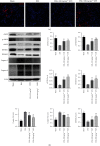Cysteine-Rich Whey Protein Isolate (CR-WPI) Ameliorates Erectile Dysfunction by Diminishing Oxidative Stress via DDAH/ADMA/NOS Pathway
- PMID: 35355865
- PMCID: PMC8960025
- DOI: 10.1155/2022/8151917
Cysteine-Rich Whey Protein Isolate (CR-WPI) Ameliorates Erectile Dysfunction by Diminishing Oxidative Stress via DDAH/ADMA/NOS Pathway
Abstract
Nitric oxide synthase- (NOS-) dependent endothelial dysfunction induced by oxidative stress (OS) is assumed to play a pivotal role in the pathogenesis and progression of diabetes mellitus-related erectile dysfunction (DMED). Cysteine-rich whey protein isolate (CR-WPI) is a widely used protein supplement and has been confirmed to reduce reactive oxygen species (ROS) by increasing cellular antioxidant glutathione (GSH). However, it is currently unknown whether CR-WPI elicits therapeutic effects in DMED. Here, we provide diabetic rats with CR-WPI to determine its effect on DMED and the underlying mechanisms. The results suggest that CR-WPI supplementation increased GSH biosynthesis and reduced ROS content and simultaneously upregulated the dimethylarginine dimethylaminohydrolase (DDAH)/asymmetrical dimethylarginine (ADMA)/nitric oxide synthase (NOS) metabolic pathway. Evaluation of intracavernous pressure (ICP) also showed an improvement of penile erectile function in CR-WPI-treated rats. The results of the vitro cell culture showed that glutathione pretreatment protected corpus cavernosum smooth muscle cells (CCSMC) from H2O2-induced apoptosis by decreasing Caspase 9 and Caspase 3 expressions. These results augur well for the potential therapeutic application of dietary CR-WPI supplementation for treating diabetic erectile dysfunction.
Copyright © 2022 Kefan Li et al.
Conflict of interest statement
Jimmy Gutman consults with a whey protein distributor.
Figures






Similar articles
-
Epigallocatechin-3-gallate ameliorates erectile function in aged rats via regulation of PRMT1/DDAH/ADMA/NOS metabolism pathway.Asian J Androl. 2017 May-Jun;19(3):291-297. doi: 10.4103/1008-682X.178486. Asian J Androl. 2017. PMID: 27080477 Free PMC article.
-
Fermented Gynochthodes officinalis (F.C.How) Razafim. & B.Bremer alleviates diabetic erectile dysfunction by attenuating oxidative stress and regulating PI3K/Akt/eNOS pathway.J Ethnopharmacol. 2023 May 10;307:116249. doi: 10.1016/j.jep.2023.116249. Epub 2023 Feb 11. J Ethnopharmacol. 2023. PMID: 36775080
-
Baicalein Alleviates Erectile Dysfunction Associated With Streptozotocin-Induced Type I Diabetes by Ameliorating Endothelial Nitric Oxide Synthase Dysfunction, Inhibiting Oxidative Stress and Fibrosis.J Sex Med. 2020 Aug;17(8):1434-1447. doi: 10.1016/j.jsxm.2020.04.390. Epub 2020 Jun 23. J Sex Med. 2020. PMID: 32586748
-
The DDAH/ADMA/NOS pathway.Atheroscler Suppl. 2003 Dec;4(4):33-40. doi: 10.1016/s1567-5688(03)00032-1. Atheroscler Suppl. 2003. PMID: 14664901 Review.
-
Dimethylarginine dimethylaminohydrolase (DDAH): expression, regulation, and function in the cardiovascular and renal systems.Am J Physiol Heart Circ Physiol. 2007 Dec;293(6):H3227-45. doi: 10.1152/ajpheart.00998.2007. Epub 2007 Oct 12. Am J Physiol Heart Circ Physiol. 2007. PMID: 17933965 Review.
Cited by
-
Ubiquinone (Coenzyme Q-10) Supplementation Influences Exercise-Induced Changes in Serum 25(OH)D3 and the Methyl-Arginine Metabolites: A Double-Blind Randomized Controlled Trial.Antioxidants (Basel). 2024 Jun 23;13(7):760. doi: 10.3390/antiox13070760. Antioxidants (Basel). 2024. PMID: 39061829 Free PMC article.
-
Exploring the role of glycolysis in the pathogenesis of erectile dysfunction in diabetes.Transl Androl Urol. 2025 Mar 30;14(3):791-807. doi: 10.21037/tau-2025-6. Epub 2025 Mar 26. Transl Androl Urol. 2025. PMID: 40226065 Free PMC article.
References
MeSH terms
Substances
LinkOut - more resources
Full Text Sources
Medical
Research Materials

